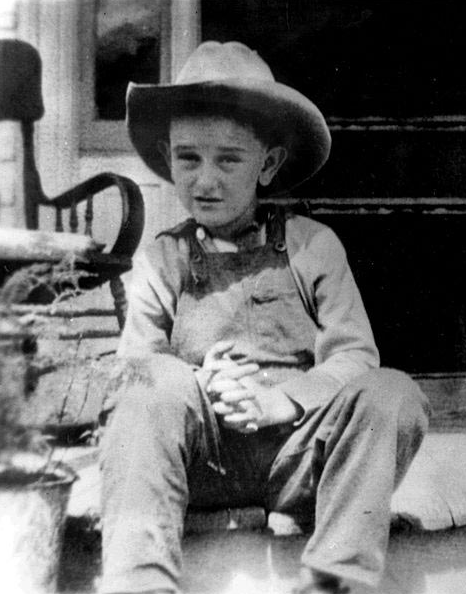Childhood, education and career of Lyndon Johnson
Early Years
In Stonewall, Texas, Lyndon Baines Johnson was born to Samuel Ealy Johnson Jr. and Rebekah Baines on August 27, 1908. He had three sisters and a brother and was the oldest of his siblings. His father was a rancher who also dabbled in politics.
Lyndon B. Johnson’s parents’ interests influenced his later political career and the causes he advocated as a Congressman and president. For twelve years, his father served as a state senator; thus, Sam Ealy Jr. was an influential and prominent member of the Democratic Party. Lyndon was on the campaign trail for his father’s re-election when he was ten years old. He stood by his father’s side at parliamentary sessions when he was thirteen. Lyndon Johnson learned the “political realities of life” and the qualities needed to be a good candidate due to these events.
Rebekah Baines, Lyndon Johnson’s mother, was one of the few college-educated women in the region. Her passion was education. She taught elocution and debate tactics to the kids in the community from this house. Lyndon must have paid attention to her orders because he, too, was a debate coach for a school team. In the tradition of Ben Franklin and Thomas Jefferson, young Lyndon taught, among other things, that we should never develop views dependent on first experiences. That authority should be used for the greater good.
Education
He grew as a confident and outgoing young man who excelled at public speaking, debate, and baseball. At the age of 15, Lyndon Johnson graduated from Johnson City High School in 1924.
Upon graduating from high school, he worked some odd jobs for two years and worked for his cousin’s law office shortly. He then enrolled in San Marcos, Southwest Texas State Teachers College. While completing his education, he began acting like a tutor. During this time, he was deeply affected by the extreme poverty experienced by some of his pupils. Johnson was an average student who thrived in extracurricular sports, including journalism, student leadership, and debate. He did exceptionally well in his student teaching and was transferred to a tiny Hispanic school in a poor neighborhood. Johnson took over the Cotulla academy, moving the long-forgotten students and instilling in them a sense of optimism and pride in their accomplishments. Johnson was deeply affected by his firsthand experience with the impact of hardship and injustice on his peers. It ignited a lifelong interest in him to pursue answers to these issues. In 1930, he earned his bachelor’s degree.
Early Political Career
The United States was in the Great Depression when he graduated. His first job as a teacher was paid $1,530 per year. Johnson performed admirably once again, but his unfinished political service in his spare time had fueled other desires. His teaching career was, predictably, short.
Following his graduation, he pursued a teaching career as well as a political career. Johnson was elected speaker of Little Congress, a party of Congressional aides, in 1931 after Congressman Richard M. Kleberg appointed him as his legislative assistant.
He tied the knot with Claudia Alta “Lady Bird” Taylor, a fellow Texan, on November 17, 1934, and they had two children, Lynda and Luci. Lady Bird Johnson, a soft-spoken but well-educated woman from a well-to-do household, was a crucial figure in Johnson’s political success.
In 1935, Johnson moved to Texas to become the Texas representative of the National Youth Administration, a New Deal initiative spearheaded by President Franklin D. Roosevelt. The latter is a political hero of Johnson, that assisted young people in finding employment or volunteering during the Great Depression.
In 1941, Lyndon Johnson served in the US Naval Reserved during World War II was commissioned as a lieutenant commander and sent to the South Pacific. Japanese pilots attacked his plane during a combat flight, and he was awarded the Silver Star for bravery. In 1942, he resumed his political career.
Republicans gained a share of votes in both the House and Senate in the 1952 general election. Johnson, a Democrat, was elected minority leader by his peers in 1953. He was the Senate’s youngest minority leader ever. The Democrats took over the next year, and Johnson became the majority leader.
Vice Presidency
In 1960, the Democrats elected Johnson as their vice-presidential candidate to run alongside John F. Kennedy, the Democratic presidential nominee. The Kennedy-Johnson ticket narrowly defeated Republican nominee Richard Nixon in the race.
On January 20, 1961, Johnson was sworn in as Vice President of the United States. He was in charge of the space program at the time, and he advocated for equal opportunities laws for minorities. He also backed the president’s decision to send American military advisers to South Vietnam to aid in the war against the communist insurgency.
Road to White House
President John F. Kennedy passed away in Dallas, Texas, on November 22, 1963. Lee Harvey Oswald assassinated him. Within hours of Kennedy’s assassination, Johnson took the presidential oath. Following the demise of John F. Kennedy, he became president when the country was in shock and mourning.
Lyndon Johnson addressed the public as soon as he took control, informing them that he would carry out the preparations that Kennedy had been contemplating at the time of his death. He was a strong supporter of the civil rights amendment that Kennedy had fought for. He went on to sign the Civil Rights Act of 1964.
President Lyndon B. Johnson was successful and planned to run for re-election in 1968. Since stepping down as president on January 20, 1969, he stunned the country by declaring that he would not seek re-election, and he returned to his ranch.
US Presidents | ||
